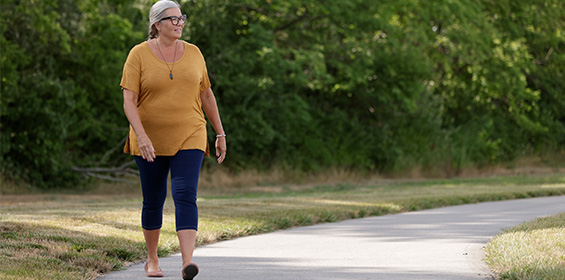April is National Foot Health Awareness Month – what better time to recognize the important role feet play in our daily routines and in our overall health? Not only is it important to understand the steps we can take to prevent foot and ankle issues, but also who to turn to when expert care is needed.
As a podiatric surgeon, Dr. Stanton Wilhite spends his days treating a variety of foot and ankle conditions, including diabetic foot care, fractures, sports injuries and arthritis. He’s also passionate about educating patients on being proactive about their foot health. Dr. Wilhite says he doesn’t have a “typical” patient because, at one point or another, most people will experience an issue with a foot or ankle. We asked Dr. Wilhite what people can do to take care of their feet and help protect their health. He provided the following suggestions.
Routinely inspect feet and toenails. “First and foremost, if you are diabetic, maintaining foot health is instrumental to protecting your overall health,” Dr. Wilhite said. “Diabetes is very prevalent in our society today, and diabetic patients should inspect their feet regularly and not delay if they notice out-of-the ordinary signs or symptoms.” Starting with a clean foot, look for areas of pressure or concern, and be aware of issues like burning, tingling or numbness. Keep an eye on any cuts, blisters, calluses or ingrown toenails. Make sure nails grow straight and are free of infection. Look for redness, pain, discoloration or thick yellow nails.
Wear appropriate shoes. Shoes that are too tight or narrow can cause long-term problems. Not only should shoes fit properly, but they should be practical and comfortable. Choose a shoe that is stable, supportive and provides cushion. Also, making sure you have proper-fitting shoes for sports and physical activity is important; make sure you replace them when they wear out so that your foot gets the support it needs. Learn more about properly fitting shoes at Healthline.
Keep feet dry and protected. Bacterial or fungal conditions, like athlete’s foot, are preventable by keeping feet dry and wearing proper feet coverings if showering in a public place. Make sure your feet are dry before putting on socks, as moisture can increase friction between the foot and sock, leading to blisters.
Use heat or ice appropriately. For sore, arthritic feet, soak in warm water to increase blood flow, decrease inflammation and soothe bones and ligaments. For sudden injuries, ice the area of concern to decrease inflammation. Additionally, taking NSAIDs or other anti-inflammatory medications can help ease the pain, but talk with your doctor before introducing new medications.
Stretch before and after activity. Before a workout or activity, don’t neglect to warm up the muscles in your feet and ankles. Achilles stretch, ankle circles and chair pose are three easy stretches to wake up your ankles, no equipment needed. Learn how to do these stretches, plus several more, at Healthline. To strengthen the muscles in your feet, incorporate exercises such as toe splay, toe curls and marble pickup. Learn more about these strengthening exercises at Medical News Today.
Keep your ankles strong. While the ankle is designed to be flexible and strong enough to support one’s body weight, a twist or misstep can lead to a painful sprain. If you notice you’re having a lot of ankle sprains, it may be due to ankle instability. Find suggestions to strengthen ankles and prevent ankle sprains at ciocenter.com/blog/how-to-strengthen-ankles-and-prevent-ankle-sprains/.
Modify or stop activity when pain occurs. Listen to your body – if something hurts or just doesn’t feel right, modify the activity or stop completely. It could be improper form or the beginning of an injury. If pain persists, consult a doctor.
Eat healthy foods. Nutrition plays an important role in our overall health and affects different body parts, even your feet. Look for foods that are anti-inflammatory, rich in calcium, vitamin D and healthy fats and low in sodium. Learn more about these recommended foods and the effects they have on your foot health at Everyday Health.
Watch your step! Use caution when walking or running on uneven terrain.
Dr. Wilhite says if someone has chronic foot (or ankle) pain, he recommends trying conservative treatments first, like orthotics or injections. “If conservative treatments fail, depending on the condition and severity, we may discuss surgery or setting the patient up with a chronic pain specialist to manage their foot pain,” he continued. “Regardless, we’re here to help get them back on their feet.” Learn more about our foot and ankle team at ciocenter.com/services/ankle-foot/ or call 800-622-6575 to schedule an appointment.

